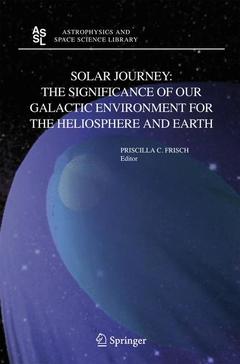Description
Solar Journey: The Significance of Our Galactic Environment for the Heliosphere and Earth, 2006
Astrophysics and Space Science Library Series, Vol. 338
Coordinator: Frisch P.C.
Language: English
Subject for Solar Journey: The Significance of Our Galactic...:
Keywords
Accretion; Galaxy; Heliosphere; Planet; Planetary system; Solar System; Solar wind; Sun; solar; stellar
Publication date: 11-2014
413 p. · 15.5x23.5 cm · Paperback
Publication date: 09-2006
413 p. · 15.5x23.5 cm · Hardback
Description
/li>Contents
/li>Comment
/li>
Written by experts who created the field, this volume explores uncharted scientific territory, with articles discussing the effect of our galactic environment on the heliosphere, planetary system and Earth. Leading experts in diverse fields discuss the physical changes expected as the heliosphere adjusts to its galactic environment. Topics include the interaction between solar wind and interstellar dust and gas, cosmic ray modulation, magnetospheres, variations in the solar environment, and the cosmic ray isotope record preserved in paleoclimate data.
This volume explores uncharted scientific territory, with comprehensive articles discussing the fascinating interdisciplinary field of the effect of our galactic environment on the heliosphere, planetary system and Earth, and written by leading experts who created this field.
The breadth of these articles addresses all aspects of this problem, and lay the foundation for future studies of the relevance of our galactic environment to the solar system, Earth and planets.
Our detailed knowledge of the heliosphere, combined with the extrapolation of this knowledge to diverse heliosphere boundary conditions, provides a foundation for studies of the astrospheres of external cool stars.
Detailed physical models show that the interstellar-modulated heliosphere (the solar wind bubble) governs the flux of cosmic rays at Earth, and models and data indicate this is a major factor in cloud cover and the climate. This major scientific point is discussed from all views, including the cosmic ray modulation for variable interstellar environments, paleoclimate records of this modulation, and the importance of separating interstellar from solar activity modulation of the heliosphere.
This volume presents the first full scientific discussion of this topic, still in its infancy, and discusses the physics behind the scientific models and data that are required to understand the topic.




